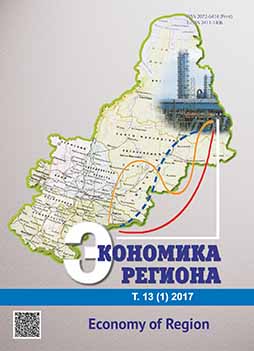Социальное благополучие регионов Российской Федерации.
Social Well-Being of the Russian Federation Regions
Author(s): Marina Yuryevna MalkinaSubject(s): Economy, Geography, Regional studies
Published by: Институт экономики Уральского отделения Российской академии наук
Keywords: social well-being; welfare; region; inequality; A. Sen function; Theil index; Theil-Bernoulli index; convergence; divergence; decomposition;
Summary/Abstract: The paper aims at analyzing the differences in the level of Russian regions social well-being in 2004–2014. The objectives of the research are the assessment of the regional social well-being; evaluation of the interregional inequality and the degree of regions convergence/divergence in social well-being; estimation of the factors contributed to it. The social well-being is presented as a four-factor multiplicative model, based on the A. Sen extended function, which includes GDP per capita, share of personal incomes in GRP, cost of living index in the region and intra-regional income inequality. We evaluate the degree of interregional inequality in social well-being on the basis of generalized entropy indices (Theil index and Theil-Bernoulli index). The authors determined a contribution of factors to the interregional inequality according to the Duro-Esteban inequality decomposition technique. According to our hypothesis, the interregional differences decrease as we go from GRP per capita towards nominal and real income and social well-being of regions due to three compensation effects: distributive one, cost of living and intraregional inequality. The dynamics of these effects defines the character and extent of convergence. As a result of the research, we constructed the map of Russian Federation regions by social well-being, and discovered interregional differences in dynamics. Weighted entropy indices allowed to reveal the turning point in the tendency of the accelerated convergence of the Russian regions in 2009, and according to the unweighted entropy indices, there is a smooth turn to divergence in 2011. We determined the contribution of four factors and three crossings of the model in the formation of interregional differences by social well-being in statics. In dynamics, we revealed the positive impact on the convergence by production and distribution factors and the negative impact on it by the factors of cost of life and intraregional inequality. The obtained results are applicable to the assessment of the effectiveness of the regional policy and interbudgetary equalization and to the development of the measures to improve it.
Journal: Экономика региона
- Issue Year: 13/2017
- Issue No: 1
- Page Range: 49-63
- Page Count: 15
- Language: Russian

